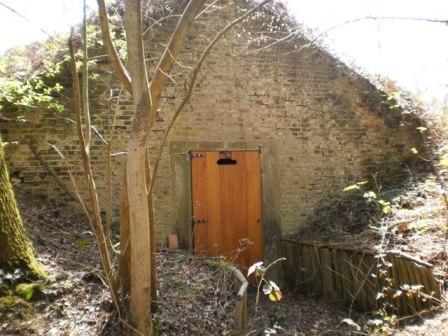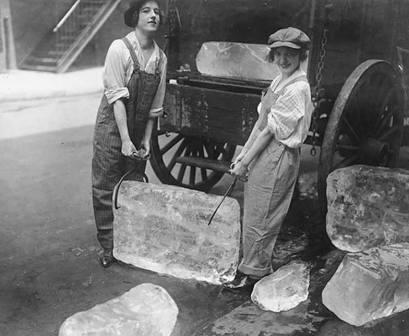In a cool environment food keeps longer and better. A well-insulated and firmly closing wardrobe where you put ice in stays cool. So it’s an cool box or refrigerator.
Place the box in a cool place.
 Open and close them gently so the cold (air) is not sucked out by the moving door. Therefore it makes sense to fill empty space with empty boxes to keeping the cold air even better in the coffin.
Open and close them gently so the cold (air) is not sucked out by the moving door. Therefore it makes sense to fill empty space with empty boxes to keeping the cold air even better in the coffin.
But how do you get ice? This can be kept in an ice house.
The tradition to harvest ice is in Squam Lake, New Hampshire still held annually in honor.
https://www.youtube.com/watch?v=9xE6Wu7gVmE
In 1919 this was done already / still.
https://www.youtube.com/watch?v=3x9rc-54s-I
Baltazar Ushca (74 years in 2019) is the last ice merchant in the Andes of Ecuador. Twice a week he climbs the 6,300 m high volcano Chimborazo to pick up with his 3 donkeys (2 block, 40kg) ice to cool drinks.
A fine, cool storage cellar for potatoes, cabbage and vegetables people once got by storing everything in barges. The underwater part stays fresh. Water only freezes when it’s freezing long and hard enough. With some wall insulation, the temperature stays almost constant for long (between 4 and 8 degrees).
Our ancestors were very resourceful with the resources they had.
Butter was in the summer often kept in a bucket in the well, so it did not melt.
The principle was formerly known, but only in 1859 the Frenchman Ferdinand Carre built a fridge. After its launch at the World Exhibition in London in 1862 it was a huge success.
‘Refrigerator: place where you store leftovers till you have to discard them.’(Paraphrasing Al Boliska)
Ice house
 An icehouse is a freestanding, usually barrel shaped and deep cellar (5 meter and even more) or pit in which large chunks of ice from a nearby pond or ditch consecutive were stored in the winter. The pit is isolated as much as possible, for example, with hay. Often they had double walls ( with peat between ) and an earthen dome with trees (for shade) with the entrance facing north. There is a deck or sand bottom to drain melt water. Good ventilation to dissipate humid air is also important.
An icehouse is a freestanding, usually barrel shaped and deep cellar (5 meter and even more) or pit in which large chunks of ice from a nearby pond or ditch consecutive were stored in the winter. The pit is isolated as much as possible, for example, with hay. Often they had double walls ( with peat between ) and an earthen dome with trees (for shade) with the entrance facing north. There is a deck or sand bottom to drain melt water. Good ventilation to dissipate humid air is also important.
Because of the depth the space remains well cool . Because cold air sinks, this remains cold as long as there is enough ice stored. You can keep a quantity of ice so all year (even 2 years!). In warmer periods ice can be moved up from the basement to use in a refrigerator. In middle class it was the ‘chic’ to offer guests ice in the summer The oldest known ice cellars were unearthed in Chinese Turkestan and date back to the 3rd century AD. In China, the practice is even older (and still exist).
The lower the temperature , the closer water molecules are together and the closer and harder the ice is. At 0 degrees C ice has a density of 0.917 grams per cm³. At -180 it is 0.9340 grams in a cm³. The difference between -1 and -10 therefore is very little.
The restaurant ran out of ice cubes. They lost the recipe.
Freezer energy tips
Per 2 mm ice in the freezer you use 10% more electricity.
Defrost your freezer (for cleaning) in (the beginning and at the end of) the winter . You can then convert the content without problems outside in the freezing cold outside.
Fill empty space in the freezer (and fridge) with closed boxes, so the cold air will when opening and closing the box, not change place with warmer air.
